The Effect of Annealing on Additive Manufactured ULTEM™ 9085 Mechanical Properties
Abstract
1. Introduction
2. Literature Review
3. Experiment Setup
3.1. Derivation of Annleaing Specifications
3.2. Coupons and Orientation in Experiment
3.3. Printing Parameters
3.4. Direct Image Correlation
3.5. Equipment
4. Experimental Results
4.1. Coupon Dimensional Measurement
4.2. Mechanical Properties
4.3. Fractography Anaylsis
4.4. Mesostructure Analysis
4.5. DIC Results
5. Conclusions
- All annealed coupons have expanded in the layering direction, indicating a thermal stress relief. This signifies that the FFF prints are significantly stressed in the direction of layering, which will subsequently expand once it has been annealed close to the Tg for prolonged periods of time.
- Coupons are generally more ductile after annealing, achieving up to 27% and 5% improvement for XY and XZ annealed coupons, respectively. DIC results show a reduction in strain concentration, which decreases the likelihood of localized failure due to high strain concentration. Tensile strength, on the other hand, dropped slightly about 3.4% and increased 1.4% for XY and XZ annealed specimens, respectively.
- Mesostructure and fracture surface analysis shows increased coalescence and chevrons indicating higher degree of necking during fracture, a sign of increased ductility.
- It was shown that thermal annealing can be carried out without the aid of specialized molds, with most of the coupons are still dimensionally stable, retaining its geometry.
Author Contributions
Funding
Institutional Review Board Statement
Informed Consent Statement
Data Availability Statement
Conflicts of Interest
References
- Chua, C.K.; Leong, K.F. 3D Printing and Additive Manufacturing: Principles and Applications Fifth Edition of Rapid Prototyping, 5th ed.; World Scientifc: Singapore, 2017. [Google Scholar]
- Moon, S.K.; Tan, Y.E.; Hwang, J.; Yoon, Y.-J. Application of 3D printing technology for designing light-weight unmanned aerial vehicle wing structures. Int. J. Precis. Eng. Manuf. Green Technol. 2014, 1, 223–228. [Google Scholar] [CrossRef]
- Lu, C.; Qi, M.; Islam, S.; Chen, P.; Gao, S.; Xu, Y.; Yang, X. Mechanical performance of 3D-printing plastic honeycomb sandwich structure. Int. J. Precis. Eng. Manuf. Green Technol. 2018, 5, 47–54. [Google Scholar] [CrossRef]
- Zhang, H.; Moon, S.K.; Ngo, T.H. 3D Printed Electronics of Non-contact Ink Writing Techniques: Status and Promise. Int. J. Precis. Eng. Manuf. Green Technol. 2019, 7, 1–14. [Google Scholar] [CrossRef]
- Hart, K.R.; Dunn, R.M.; Sietins, J.M.; Mock, C.M.H.; Mackay, M.E.; Wetzel, E.D. Increased fracture toughness of additively manufactured amorphous thermoplastics via thermal annealing. Polymer 2018, 144, 192–204. [Google Scholar] [CrossRef]
- Kim, J.S.; Lee, C.S.; Kim, S.-M.; Lee, S.W. Development of data-driven in-situ monitoring and diagnosis system of fused deposition modeling (FDM) process based on support vector machine algorithm. Int. J. Precis. Eng. Manuf. Green Technol. 2018, 5, 479–486. [Google Scholar] [CrossRef]
- Fischer, M.; Schöppner, V. Fatigue behavior of FDM parts manufactured with Ultem 9085. Jom 2017, 69, 563–568. [Google Scholar] [CrossRef]
- Rane, R. Enhancing Tensile Strength of FDM Parts Using Thermal Annealing and Uniaxial Pressure. Master’s Thesis, The University of Texas at Arlington, Arlington, TX, USA, 2019. [Google Scholar]
- Luchinsky, D.G.; Hafiychuk, H.; Hafiychuk, V.; Wheeler, K.R. Molecular Dynamics of ULTEM 9085 for 3D Manufacturing: Spectra, Thermodynamic Properties, and Shear Viscosity; National Aeronautics and Space Adminstration: Washington, DC, USA, 2018. [Google Scholar]
- Zaldivar, R.; Mclouth, T.; Ferrelli, G.; Patel, D.; Hopkins, A.; Witkin, D. Effect of initial filament moisture content on the microstructure and mechanical performance of ULTEM® 9085 3D printed parts. Addit. Manuf. 2018, 24, 457–466. [Google Scholar] [CrossRef]
- Rodriguez, J.F.; Thomas, J.P.; Renaud, J.E. Characterization of the mesostructure of fused-deposition acrylonitrile-butadiene-styrene materials. Rapid Prototyp. J. 2000, 6, 175–185. [Google Scholar] [CrossRef]
- Coogan, T.J.; Kazmer, D.O. Healing simulation for bond strength prediction of FDM. Rapid Prototyp. J. 2017, 23, 551–561. [Google Scholar] [CrossRef]
- Shelton, T.E.; Willburn, Z.A.; Hartsfield, C.R.; Cobb, G.R.; Cerri, J.T.; Kemnitz, R.A. Effects of thermal process parameters on mechanical interlayer strength for additively manufactured Ultem 9085. Polym. Test. 2020, 81, 106255. [Google Scholar] [CrossRef]
- Kumar, S.; Bhushan, P.; Sinha, N.; Prakash, O.; Bhattacharya, S. Investigation of structure–mechanical property relationship in fused filament fabrication of the polymer composites. J. Micromanufac. 2019, 2, 167–174. [Google Scholar] [CrossRef]
- Garg, A.; Bhattacharya, A. An insight to the failure of FDM parts under tensile loading: Finite element analysis and experimental study. Int. J. Mech. Sci. 2017, 120, 225–236. [Google Scholar] [CrossRef]
- Ahn, S.-H.; Montero, M.; Odell, D.; Roundy, S.; Wright, P.K. Anisotropic material properties of fused deposition modeling ABS. Rapid Prototyp. J. 2002, 8, 248–257. [Google Scholar] [CrossRef]
- Zaldivar, R.; Witkin, D.; McLouth, T.; Patel, D.; Schmitt, K.; Nokes, J. Influence of processing and orientation print effects on the mechanical and thermal behavior of 3D-Printed ULTEM® 9085 Material. Addit. Manuf. 2017, 13, 71–80. [Google Scholar] [CrossRef]
- Forés-Garriga, A.; Pérez, M.A.; Gómez-Gras, G.; Reyes-Pozo, G. Role of infill parameters on the mechanical performance and weight reduction of PEI Ultem processed by FFF. Mater. Des. 2020, 193, 108810. [Google Scholar] [CrossRef]
- Singh, R.; Kumar, R.; Farina, I.; Colangelo, F.; Feo, L.; Fraternali, F. Multi-material additive manufacturing of sustainable innovative materials and structures. Polymers 2019, 11, 62. [Google Scholar] [CrossRef]
- Luo, M.; Tian, X.; Zhu, W.; Li, D. Controllable interlayer shear strength and crystallinity of PEEK components by laser-assisted material extrusion. J. Mater. Res. 2018, 33, 1632. [Google Scholar] [CrossRef]
- Nycz, A.; Kishore, V.; Lindahl, J.; Duty, C.; Carnal, C.; Kunc, V. Controlling substrate temperature with infrared heating to improve mechanical properties of large-scale printed parts. Addit. Manuf. 2020, 33, 101068. [Google Scholar] [CrossRef]
- Sardinha, M.; Vicente, C.M.; Frutuoso, N.; Leite, M.; Ribeiro, R.; Reis, L. Effect of the ironing process on ABS parts produced by FDM. Mater. Des. Process. Commun. 2020, 3, e151. [Google Scholar] [CrossRef]
- Parker, M.E.; Arbegast, W.; Boysen, A.; West, M. Eliminating Voids in FDM Processed Polyphenylsulfone, Polycarbonate, and ULTEM 9085 by Hot Isostatic Pressing. Diploma Thesis, South Dakota Schools of Mines & Technology, Rapid City, SD, USA, 2009. [Google Scholar]
- Wang, J.; Xie, H.; Weng, Z.; Senthil, T.; Wu, L. A novel approach to improve mechanical properties of parts fabricated by fused deposition modeling. Mater. Des. 2016, 105, 152–159. [Google Scholar] [CrossRef]
- Turner, B.N.; Strong, R.; Gold, S.A. A review of melt extrusion additive manufacturing processes: I. Process design and modeling. Rapid Prototyp. J. 2014, 20, 192–204. [Google Scholar] [CrossRef]
- de Gennes, P.-G. Reptation of a polymer chain in the presence of fixed obstacles. J. Chem. Phys. 1971, 55, 572–579. [Google Scholar] [CrossRef]
- Prajapati, H.; Chalise, D.; Ravoori, D.; Taylor, R.M.; Jain, A. Improvement in build-direction thermal conductivity in extrusion-based polymer additive manufacturing through thermal annealing. Addit. Manuf. 2019, 26, 242–249. [Google Scholar] [CrossRef]
- Malekmotiei, L.; Voyiadjis, G.Z.; Samadi-Dooki, A.; Lu, F.; Zhou, J. Effect of annealing temperature on interrelation between the microstructural evolution and plastic deformation in polymers. J. Polym. Sci. Part B Polym. Phys. 2017, 55, 1286–1297. [Google Scholar] [CrossRef]
- Stratasys. ULTEM™ 9085; Stratasys: Eden Prairie, MI, USA, 2016. [Google Scholar]
- Cicala, G.; Ognibene, G.; Portuesi, S.; Blanco, I.; Rapisarda, M.; Pergolizzi, E.; Recca, G. Comparison of Ultem 9085 used in fused deposition modelling (FDM) with polytherimide blends. Materials 2018, 11, 285. [Google Scholar] [CrossRef]
- Blanco, I.; Cicala, G.; Ognibene, G.; Rapisarda, M.; Recca, A. Thermal properties of polyetherimide/polycarbonate blends for advanced applications. Polym. Degrad. Stab. 2018, 154, 234–238. [Google Scholar] [CrossRef]
- Ceruti, A.; Marzocca, P.; Liverani, A.; Bil, C. Maintenance in aeronautics in an Industry 4.0 context: The role of Augmented Reality and Additive Manufacturing. J. Comput. Des. Eng. 2019, 6, 516–526. [Google Scholar] [CrossRef]
- de Bruijn, A.C.; Gómez-Gras, G.; Pérez, M.A. Mechanical study on the impact of an effective solvent support-removal methodology for FDM Ultem 9085 parts. Polym. Test. 2020, 85, 106433. [Google Scholar] [CrossRef]
- Kohlman, W.G.; Petrie, S.P. Mechanical properties of polycarbonate–polysulfone and polycarbonate–polyetherimide blends. Adv. Polym. Technol. J. Polym. Process. Inst. 1995, 14, 111–127. [Google Scholar] [CrossRef]
- Dawkins, B.; Qin, F.; Gruender, M.; Copeland, G. Polybenzimidazole (PBI) high temperature polymers and blends. In High Temperature Polymer Blends; Elsevier: Amsterdam, The Netherlands, 2014; pp. 174–212. [Google Scholar]
- Taguchi, G.; Chowdhury, S.; Wu, Y. Taguchi’s Quality Engineering Handbook; John Wiley & Sons, Inc.: Hoboken, NJ, USA, 2005. [Google Scholar]
- Jones, E.M.C.; Mark, A. A Good Practices Guide for Digital Image Correlation; International Digital Image Correlation Society, 2018; Volume 10, Available online: https://idics.org/guide/DICGoodPracticesGuide_PrintVersion-V5h-181024.pdf (accessed on 26 May 2021).
- Savic, V.; Hector, L.; Snavely, K. Effects of Gage Section Geometry on Tensile Material Properties by Digital Image Correlation; 0148-7191; SAE: Warrendale, PA, USA, 2012. [Google Scholar]
- SABIC. ULTEM™ RESINS. Available online: https://www.sabic.com/en/products/specialties/ultem-resins/ultem-resin (accessed on 25 March 2021).
- Parrington, R.J. Fractography of Metals and Plastics. Pract. Fail. Anal. 2002, 2, 16–19. [Google Scholar] [CrossRef]
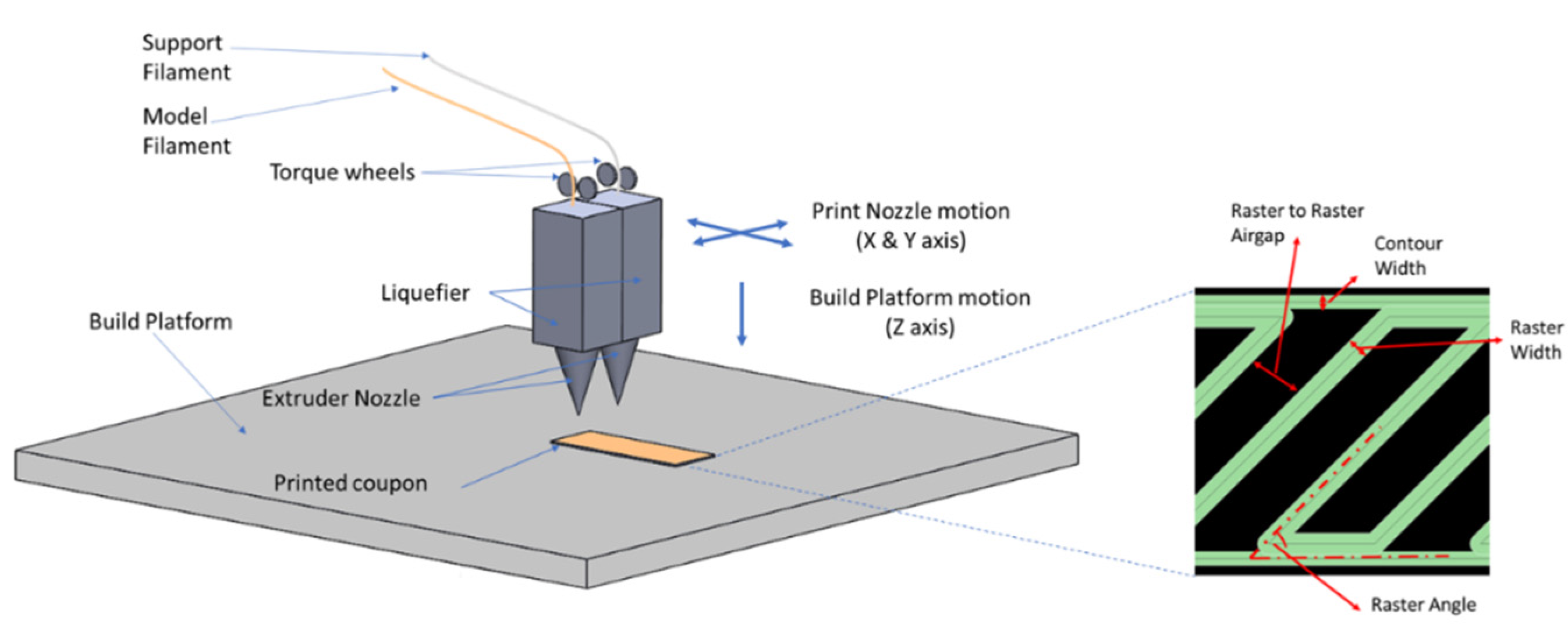

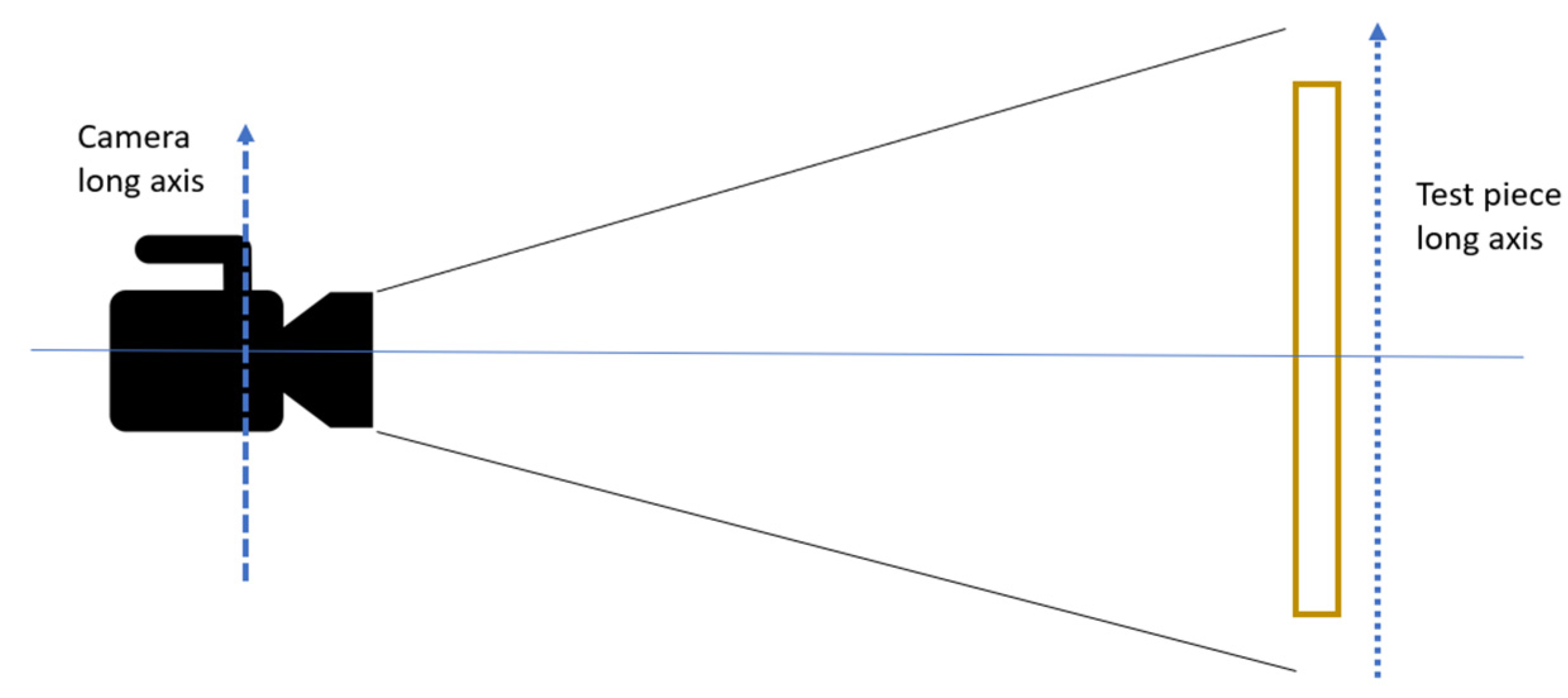

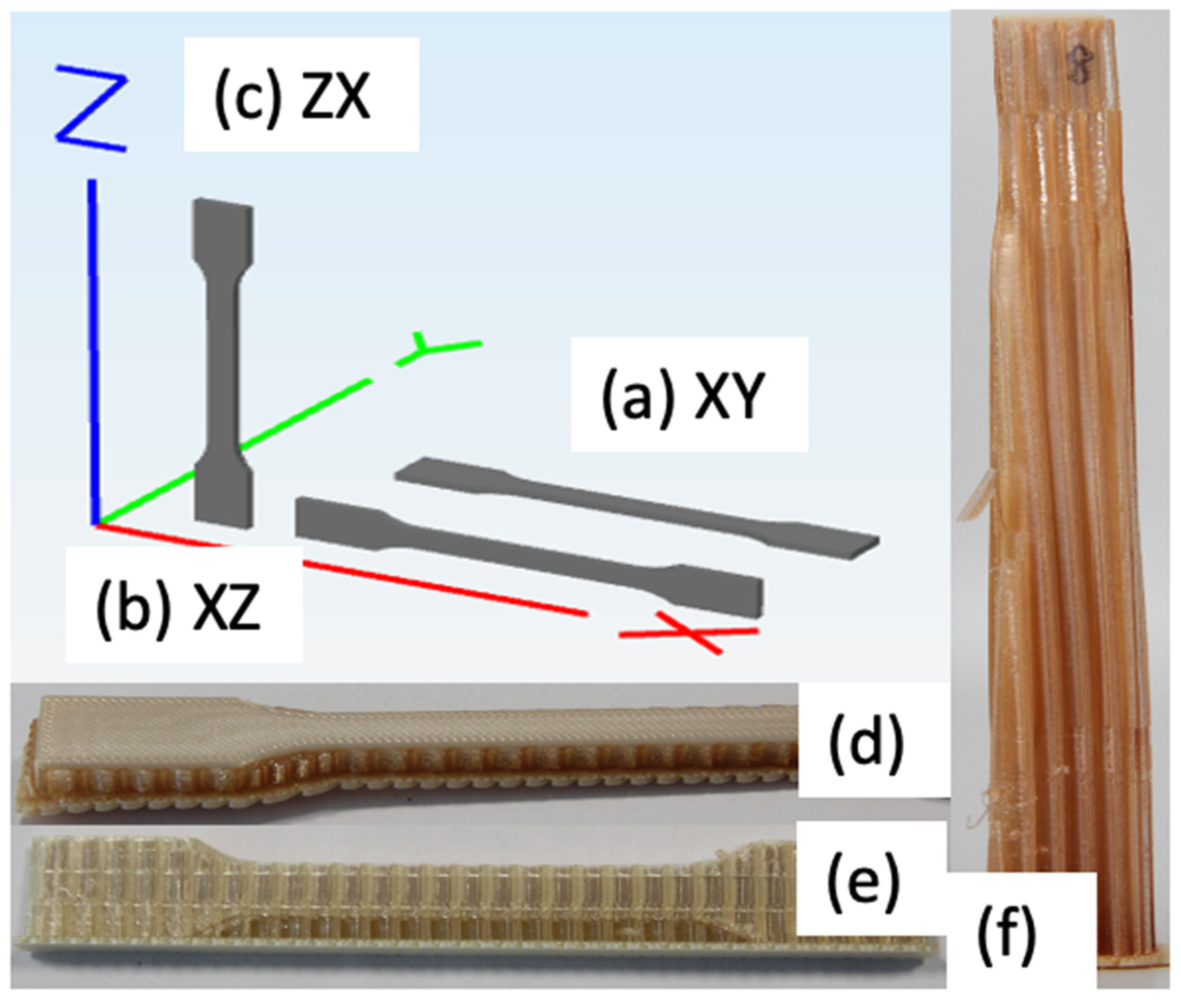
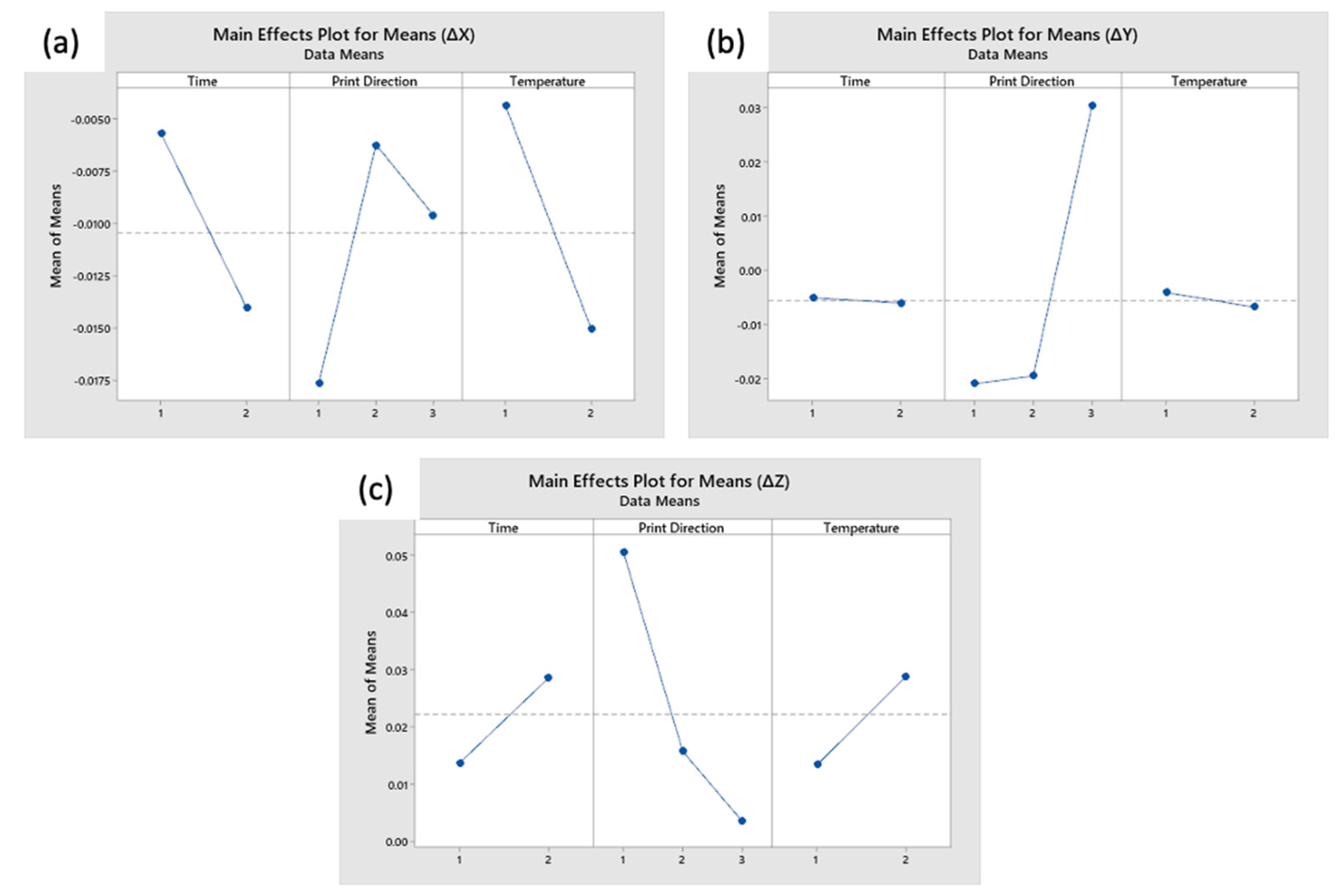




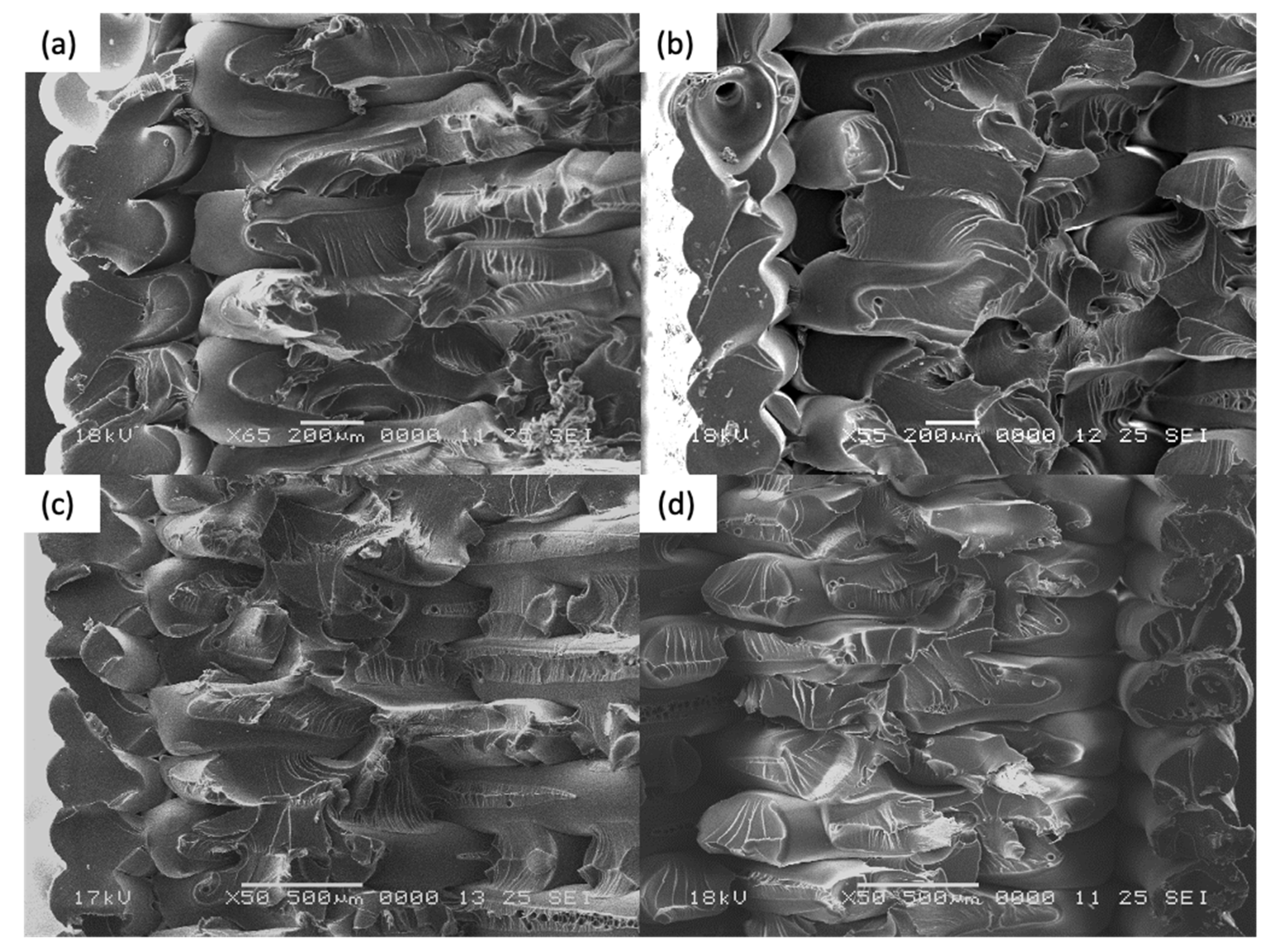

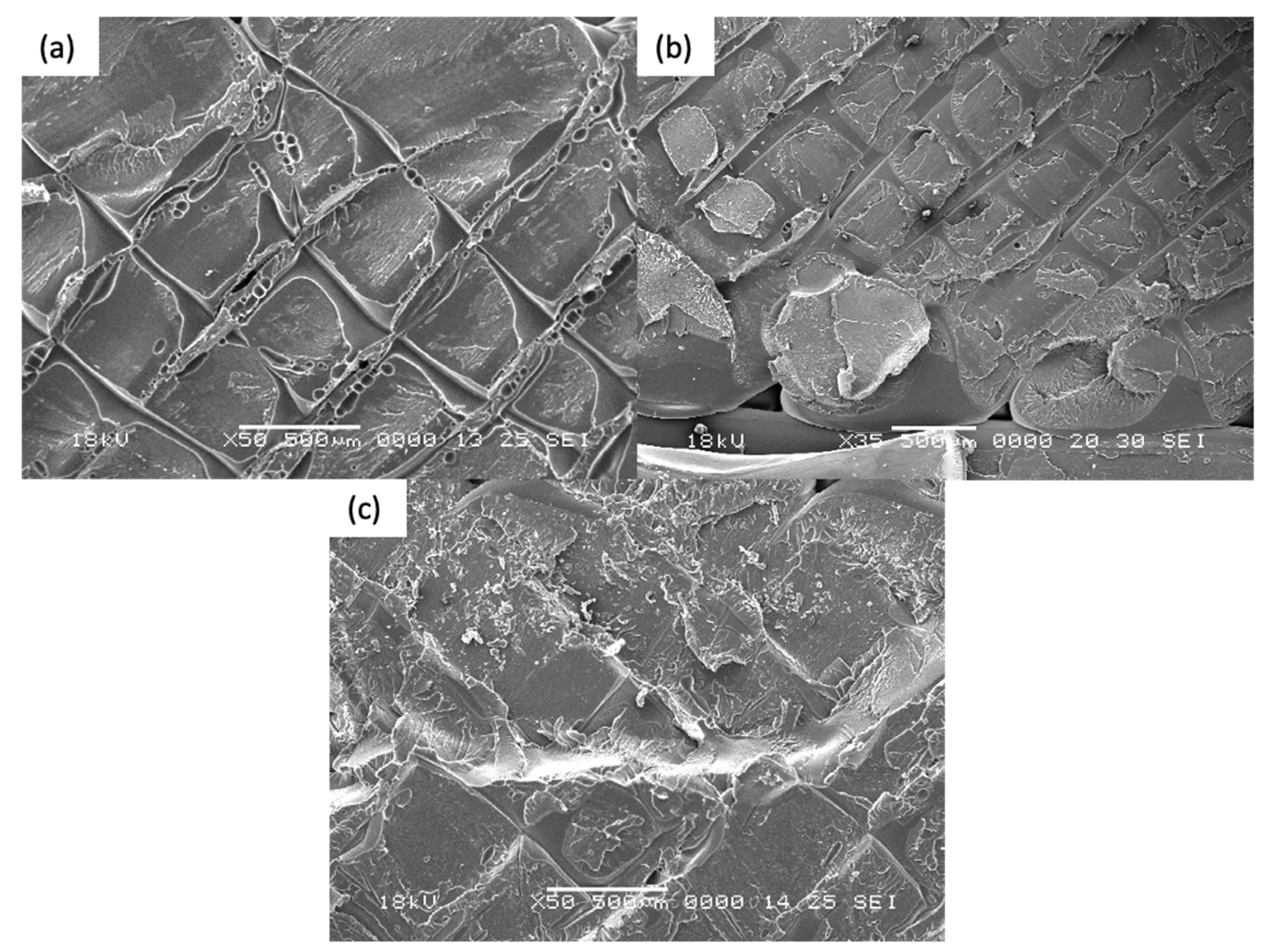
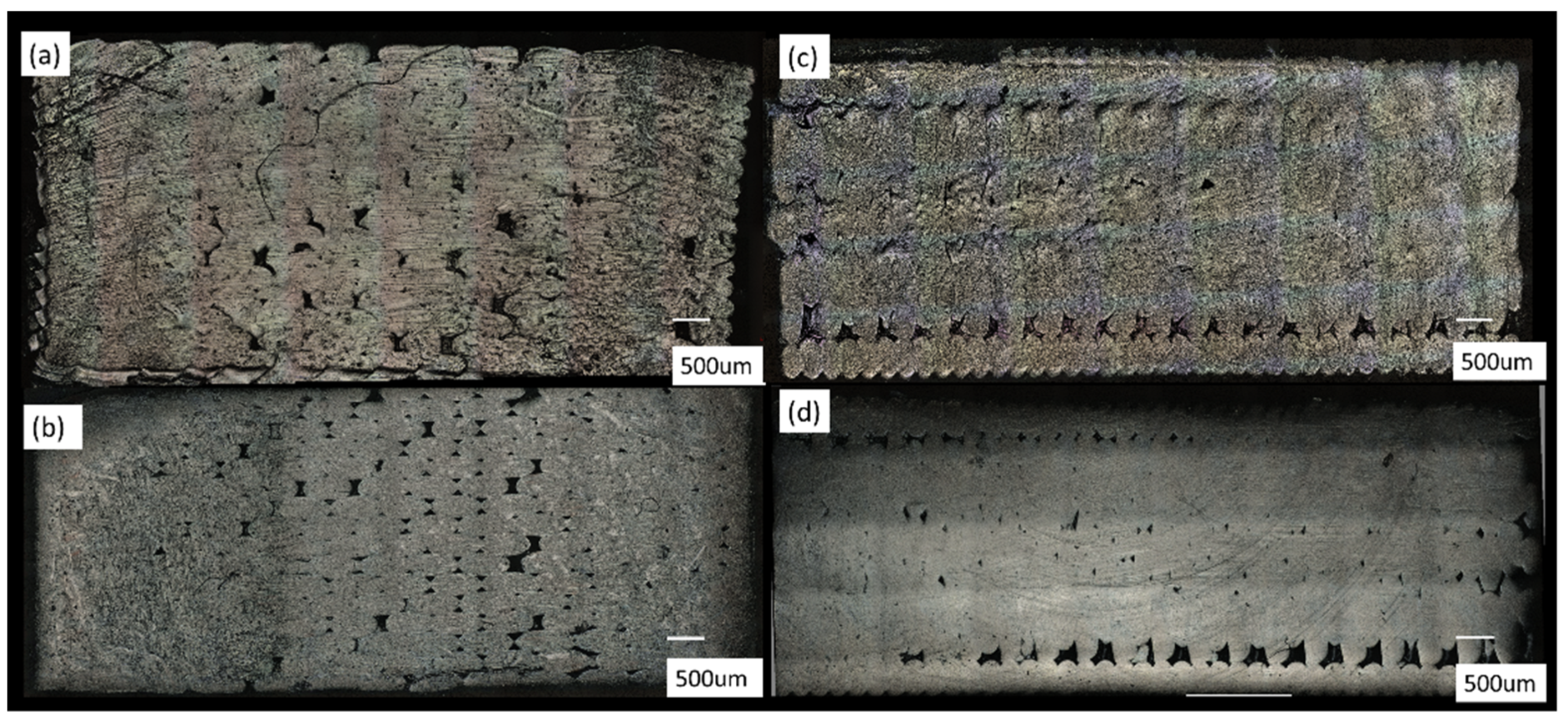
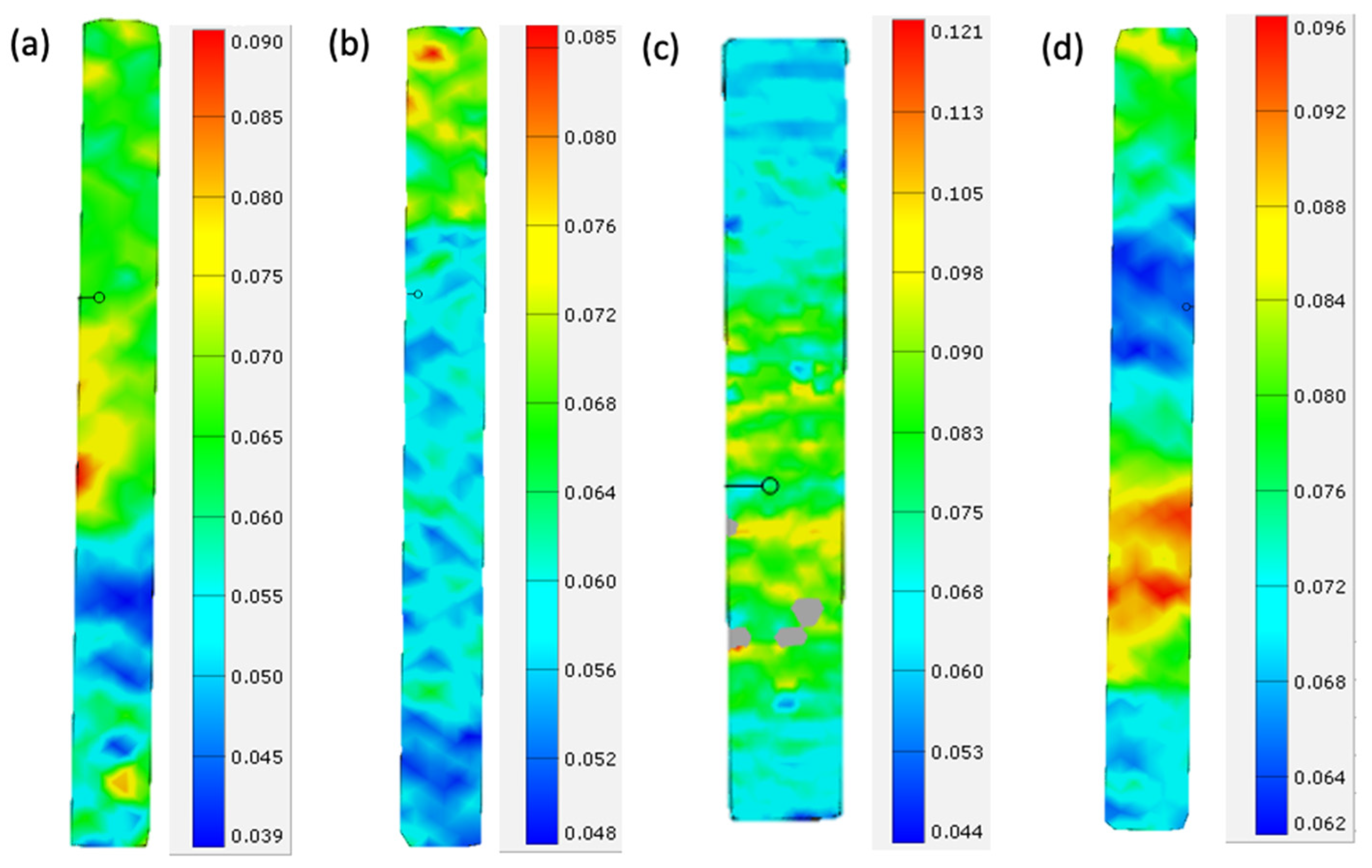
| Description | Values |
|---|---|
| Surface tension, | 38–50 × 10−7 N/m |
| Zero shear viscosity/Characteristics viscosity, | 2000–5000 Pa · s |
| Characteristics radius, |
| Factor | Level 1 | Level 2 | Level 3 |
|---|---|---|---|
| Time | 24 h | 96 h | - |
| Print Direction | XY | XZ | ZX |
| Temperature | 170 °C | 180 °C | - |
| Run/Coupon | Time (h) | Print Direction | Temperature (°C) |
|---|---|---|---|
| 1 | 24 | XY | 170 |
| 2 | 24 | XZ | 180 |
| 3 | 24 | ZX | 180 |
| 4 | 96 | ZX | 170 |
| 5 | 96 | XY | 180 |
| 6 | 96 | XZ | 180 |
| 7 | 96 | XZ | 170 |
| 8 | 96 | ZX | 180 |
| 9 | 96 | XY | 180 |
| Dimensions | Values (mm) |
|---|---|
| 170 | |
| 20 | |
| 10.0 | |
| (gauge) | 4.0 |
| (grip) | 4.0 |
| Description of Parameters | Values |
|---|---|
| Raster Width | 0.508 mm |
| Contour Width | 0.508 mm |
| Slice Height | 0.254 mm |
| Contour to Raster Air Gap | 0 mm |
| Raster to Raster Air Gap | 0 mm |
| Raster angles | +45°/−45° |
| Layers between alternating of raster angles | 1 |
| Coupon | (gauge) | (grip) | ∆X | ∆Y | ∆Z | |||
|---|---|---|---|---|---|---|---|---|
| 1 (XY) | −0.49% | −0.43% | 0.17% | 2.12% | 3.05% | −0.49% | −0.13% | 2.59% |
| 5 (XY) | −2.84% | −3.88% | −4.03% | 6.72% | 6.83% | −2.84% | −3.96% | 6.78% |
| 9 (XY) | −3.24% | −4.26% | −4.03% | 7.76% | 8.92% | −3.24% | −4.15% | 8.34% |
| 2 (XZ) | 0.00% | 0.82% | 1.64% | −6.61% | −1.38% | 0.00% | −4.00% | 1.23% |
| 6 (XZ) | −1.77% | 2.07% | 2.82% | −6.30% | 11.77% | −1.77% | 2.74% | 2.45% |
| 7 (XZ) | −0.10% | 0.74% | 1.34% | −7.00% | −2.19% | −0.10% | −4.60% | 1.04% |
| 3 (ZX) | 0.30% | −1.21% | −2.16% | 2.18% | 3.02% | −1.21% | 2.60% | 0.30% |
| 4 (ZX) | 0.39% | −0.71% | −1.32% | 2.91% | 4.09% | −0.71% | 3.50% | 0.39% |
| Ultimate Tensile Strength (MPa) | % of IM | Strain at Break (%) | |
|---|---|---|---|
| Injection Molded [39] | 88.00 | - | 72.0 |
| ZX1 | 37.21 | 42% | 2.01 |
| ZX2 | 38.38 | 44% | 2.00 |
| ZX3 | 39.40 | 45% | 2.21 |
| XY1 | 60.38 | 69% | 5.90 |
| XY2 | 61.47 | 70% | 6.16 |
| XY3 | 59.63 | 68% | 5.60 |
| XZ1 | 75.87 | 86% | 8.44 |
| XZ2 | 75.48 | 86% | 9.30 |
| XZ3 | 74.49 | 85% | 7.73 |
| Coupon | Time | Print Direction | Temperature | Ultimate Tensile Strength (MPa) | % of IM | Strain at Break (%) |
|---|---|---|---|---|---|---|
| Injection Molded [39] | - | - | - | 88.00 | - | 72.0 |
| 1 | 24 | XY | 170 | 56.48 | 64% | 4.99 |
| 2 | 24 | XZ | 180 | 75.87 | 86% | 6.38 |
| 3 | 24 | ZX | 180 | 21.10 | 24% | 1.09 |
| 4 | 96 | ZX | 170 | 33.91 | 39% | 1.83 |
| 5 | 96 | XY | 180 | 57.49 | 65% | 6.38 |
| 6 | 96 | XZ | 180 | 74.18 | 84% | 8.97 |
| 7 | 96 | XZ | 170 | 78.11 | 89% | 8.63 |
| 8 | 96 | ZX | 180 | - | - | - |
| 9 | 96 | XY | 180 | 58.46 | 66% | 7.53 |
Publisher’s Note: MDPI stays neutral with regard to jurisdictional claims in published maps and institutional affiliations. |
© 2021 by the authors. Licensee MDPI, Basel, Switzerland. This article is an open access article distributed under the terms and conditions of the Creative Commons Attribution (CC BY) license (https://creativecommons.org/licenses/by/4.0/).
Share and Cite
Zhang, Y.; Moon, S.K. The Effect of Annealing on Additive Manufactured ULTEM™ 9085 Mechanical Properties. Materials 2021, 14, 2907. https://doi.org/10.3390/ma14112907
Zhang Y, Moon SK. The Effect of Annealing on Additive Manufactured ULTEM™ 9085 Mechanical Properties. Materials. 2021; 14(11):2907. https://doi.org/10.3390/ma14112907
Chicago/Turabian StyleZhang, Yongjie, and Seung Ki Moon. 2021. "The Effect of Annealing on Additive Manufactured ULTEM™ 9085 Mechanical Properties" Materials 14, no. 11: 2907. https://doi.org/10.3390/ma14112907
APA StyleZhang, Y., & Moon, S. K. (2021). The Effect of Annealing on Additive Manufactured ULTEM™ 9085 Mechanical Properties. Materials, 14(11), 2907. https://doi.org/10.3390/ma14112907






